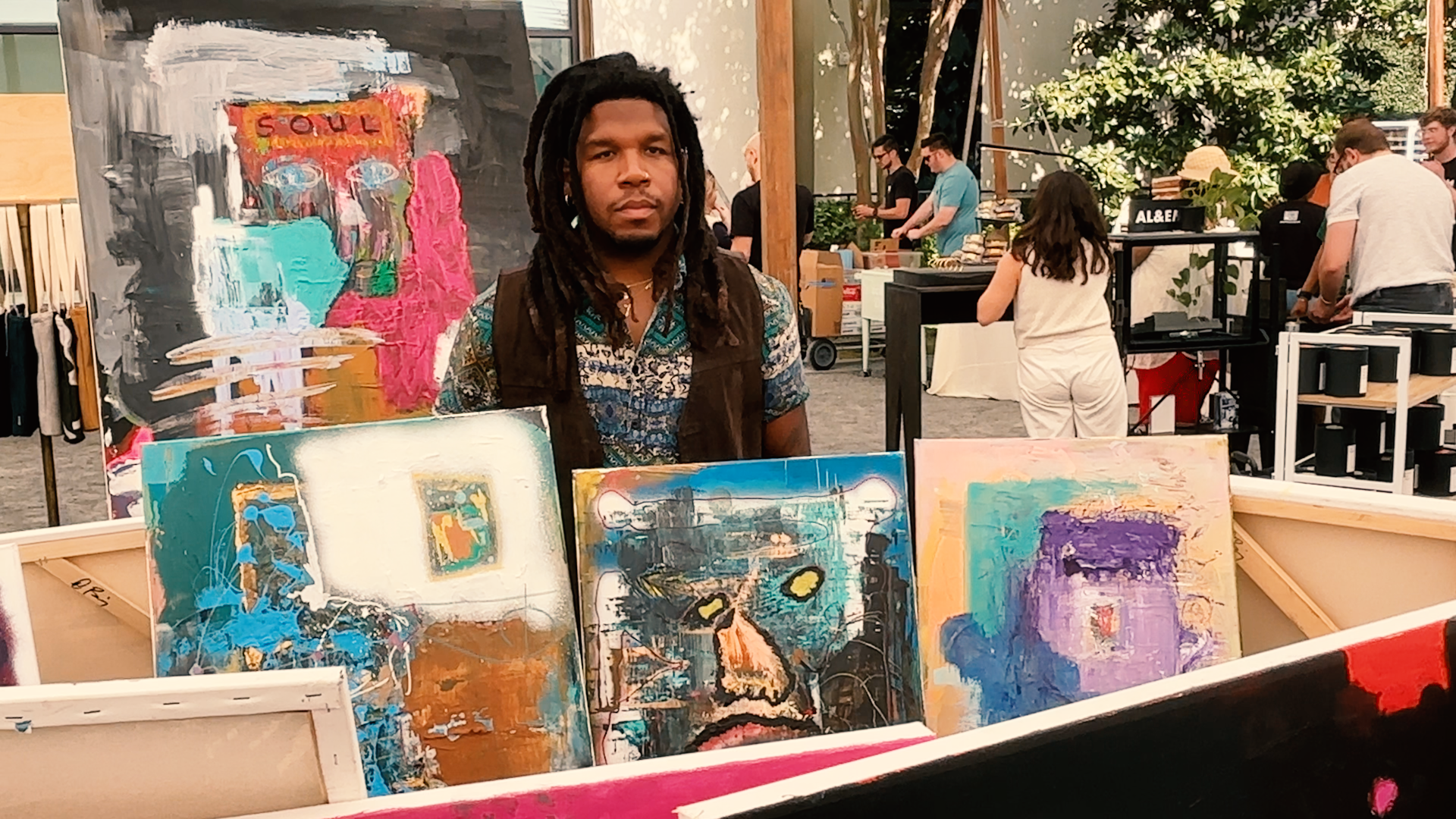Art is a calling that doesn’t always come with a guidebook. For many, like Charleston-based artist Demetrius Bing, the journey begins with nothing more than curiosity and a paintbrush. Bing, a self-taught artist, has turned his passion into a celebrated career, culminating in his first solo exhibition, Full Circle.
If you’re an aspiring artist wondering where to begin, Bing’s story offers both inspiration and practical advice. Here’s how you can take your first steps as a self-taught artist and build your craft from the ground up.
1. Start with What You Have
When Demetrius began his artistic journey at the age of 29, he didn’t start with expensive materials or a fancy studio. He started small—buying brushes and paints from Dollar Tree just to see if art was something he truly loved.
“I painted every day, starting with small canvases,” he said. “I wanted to figure out what I liked and didn’t like. That’s how I developed my style.”
How You Can Start:
- Supplies: Begin with affordable materials like student-grade acrylic paints, sketchbooks, and brushes. You don’t need professional tools to experiment.
- Space: Dedicate a small area in your home for your art, even if it’s just a corner.
- Consistency: Make art a daily habit, even if it’s just 15 minutes a day. Progress comes from practice.
2. Find Inspiration from Other Artists
For Bing, studying the works of artists like Jean-Michel Basquiat and Keith Haring was instrumental in shaping his artistic voice. He admired their ability to convey messages through bold, emotional visuals, and he incorporated those influences into his own unique style.
“I love how Basquiat and Haring used art to say something meaningful,” he shared. “It made me want to create art that connects with people emotionally.”
How You Can Start:
- Research Artists: Study the work of artists who inspire you. Look for their techniques, themes, and how they convey emotion.
- Visit Exhibitions: Attend local art shows or museums to gain exposure to different styles and mediums.
- Online Resources: Platforms like YouTube, Skillshare, and Instagram offer free or low-cost tutorials and insights from experienced artists.
3. Embrace Trial and Error
Demetrius emphasized the importance of keeping all his early works—even the ones he didn’t like. For him, they served as a record of his growth and a reminder of how far he’d come.
“It’s a process,” he said. “You have to try things, make mistakes, and learn what works for you.”
How You Can Start:
- Experiment Freely: Try different mediums—acrylics, watercolors, pastels—and see what resonates with you.
- Keep Everything: Save your early work as a benchmark for growth.
- Be Patient: Artistic skill develops over time. Don’t expect perfection right away.
4. Share Your Work with Others
One of the biggest turning points for Bing was stepping out of his comfort zone and sharing his art with the world. Whether it was through social media or local events, he realized the value of connection and feedback.
“It takes courage to put your work out there,” he admitted. “But that’s how opportunities come your way.”
How You Can Start:
- Social Media: Create accounts on Instagram or TikTok to showcase your progress and connect with other artists.
- Local Art Shows: Participate in community art events or pop-ups to meet like-minded individuals.
- Online Platforms: Sell or display your art on websites like Etsy, Redbubble, or Saatchi Art.
5. Build a Community
For Bing, relationships played a huge role in his success. From networking with fellow artists to collaborating with supportive venues, he found that art thrives in community.
“You never know who you’ll meet or how they can impact your journey,” he said. “Some of the best opportunities come from the connections you make.”
How You Can Start:
- Join Groups: Look for local artist meetups, Facebook groups, or online forums.
- Collaborate: Work with other artists to share ideas and resources.
- Support Others: Attend art shows and events to build relationships within your local art scene.
6. Stay True to Your Vision
What makes Demetrius Bing’s story so compelling is his authenticity. He doesn’t just paint to sell—he paints to express emotion and tell stories. This focus on creating meaningful art has been the foundation of his success.
“Art isn’t about following trends,” he said. “It’s about finding your voice and sharing it with the world.”
How You Can Start:
- Focus on Passion: Create art that excites and challenges you, not just what you think will sell.
- Develop Your Style: Over time, your unique artistic voice will emerge.
- Don’t Compare: Avoid getting discouraged by others’ progress. Your journey is your own.
Final Thoughts: Your Artistic Journey Starts Today
Demetrius Bing’s Full Circle exhibition is a testament to the power of hard work, creativity, and self-belief. From small Dollar Tree brushes to hosting a solo show with over 200 attendees, his story proves that you don’t need formal training to succeed as an artist—you just need the courage to start.
So grab a brush, find your inspiration, and take that first step. As Bing says, “Art isn’t just about what’s on the canvas; it’s about what’s in your heart.”
If you need help showcasing your art with a professional portfolio or website, SCPM Media can help bring your vision to life. Contact us for expert website development services tailored to artists and creatives. Visit us at SCPM Media to learn more and get started today.
Ready to begin? Check out resources like The Art of Bing for inspiration, and stay tuned to SC Power Moves for more stories that empower creativity.

